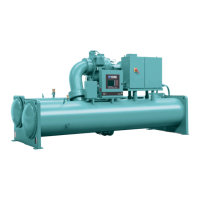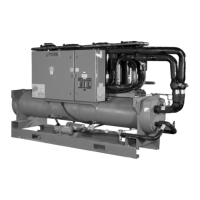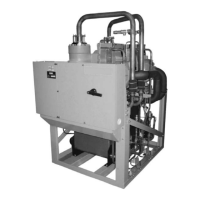Table 8: Temperature setpoint
Control source Local chilled liquid temperature setpoint
Local
Local leaving chilled liquid temperature setpoint, entered from the panel. It is programmable over the
range of 38.0°F to 70.0°F (3.3°C to 21.1°C) for water or 10.0°F to 70.0°F (-12.2°C to 21.1°C) for brine. If
Smart freeze is enabled, the range is 36.0°F to 70.0°F (2.2°C to 21.1°C) for water. The default is 45°F
(7.2°C).
ISN (BAS)
Remote leaving chilled liquid temperature setpoint value sent over communications. The setpoint
entered from the panel is ignored. If nothing is written to the address, the default is 45°F (7.2°C).
Analog remote
Local leaving chilled liquid temperature setpoint, entered from the panel plus the temperature offset
defined by the remote analog input signal. A remote device can provide an analog signal (0 mA to 20
mA, 4 mA to 20 mA, 0 VDC to 10 VDC or 2 VDC to 10 VDC) that creates the temperature offset in Analog
Remote mode. The span of the offset may be defined as 10ºF, 20ºF, 30ºF, or 40ºF (5.5°C, 11.1°C, 16.6°C,
or 22.2°C) using the local leaving chilled liquid temperature range setting from the panel. For example,
if this range setpoint is programmed for 10°F (5.5°C) and the local leaving chilled liquid temperature
setpoint is 45°F (7.2°C), then the remote device can set the leaving chilled liquid temperature setpoint
over the range 45.0ºF to 55.0°F (7.2°C to 12.8°C) as its voltage or current changes from minimum to
maximum.
Digital remote
Local leaving chilled liquid temperature setpoint, entered from the panel plus the temperature offset
defined by the remote pulse width signal. A remote device can provide a pulse width modulation
(PWM) signal in digital remote mode that creates the temperature offset in digital remote mode. The
span of the offset may be defined as 10ºF, 20ºF, 30ºF, or 40ºF (5.5°C, 11.1°C, 16.6°C, or 22.2°C) using
the local leaving chilled liquid temperature range setting from the panel. For example, if this range
setpoint is programmed for 10°F and the local leaving chilled liquid temperature setpoint is 45°F
(7.2°C), then the remote device can set the leaving chilled liquid temperature setpoint over the range
45.0ºF to 55.0°F (7.2°C to 12.8°C) as its pulse duration changes from minimum to maximum. The PWM
input is in the form of a 1 s to 11 s relay contact closure that applies 115 VAC to the I/O Board TB4- 19
for 1 s to 11 s. A contact closure time (pulse width) of 1 s produces a 0°F (0°C) offset. An 11 s closure
produces the maximum offset. The relay contacts should close for 1 s to 11 s at least once every 30
min to maintain the setpoint to the preferred value. If a 1 s to 11 s closure is not received within 30 min
of the last closure, the offset is defaulted to 0. A closure is only accepted at rates not to exceed once
every 70 s. Offset (°F/°C) = (pulse width in seconds – 1)( local leaving chilled liquid temperature range)
divided by 10.
Regardless of which method is used to select the desired leaving chilled liquid temperature
(LCHLT), the chiller controls to its own active LCHLT setpoint. The active setpoint is a target to the
programmed setpoint. When the chiller is not running, the active setpoint is set to entering chilled
liquid temperature minus a programmable offset, the default is 5°F (-15°C), but not adjusted to
less than the programmed LCHLT setpoint. When the compressor motor starts, the active LCHLT
setpoint is ramped from this value to the programmed LCHLT setpoint at the programmable LCHLT
setpoint ramp rate, the default is 0.1°F/s (0.05°C/s). This keeps the chiller from undershooting
setpoint excessively during pulldown. Any time the programmed setpoint is changed during
operation, the active setpoint is ramped to the new value at this rate.
Automatic temperature shutdown
The temperature below the LCHLT setpoint at which the chiller is desired to automatically cycle off
when load is less than the chiller minimum capability is programmed from the panel as Leaving
Chilled Liquid Temperature Cycling Offset; Shutdown. This setting defines the temperature offset
below the LCHLT setpoint where shutdown is expected. It is programmable over a range of 1°F
to 64°F (-17.2°C to 17.8°C). However the actual shutdown temperature will never be calculated
to lower than 36°F (2.22°C) for water, 34°F (1.11°C) for water with Smart Freeze enabled, or 6°F
(-25.8°C) for brine. Anytime the LCHLT setpoint is decreased, the shutdown threshold decreases
to the new LCHLT active setpoint minus offset at a rate equal to the programmed LCHLT Setpoint
Ramp Rate. Anytime the Leaving Chilled Liquid Temperature setpoint is increased, the shutdown
threshold increases to the new LCHLT active setpoint minus offset at a rate = 1/2 the programmed
LCHLT Setpoint Ramp Rate. This allows time for the chiller to change temperature without shutting
down first.
23
YMC
2
Mod B with OptiView Control Center

